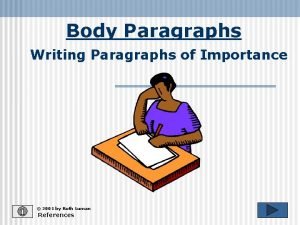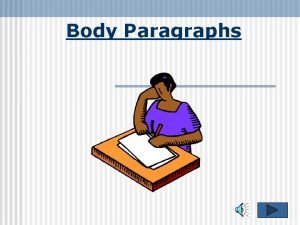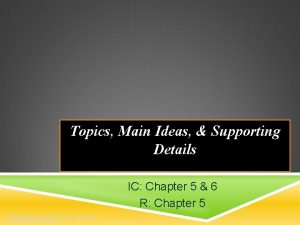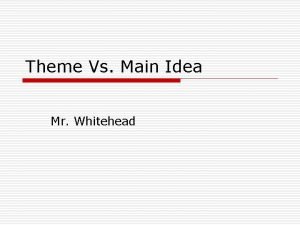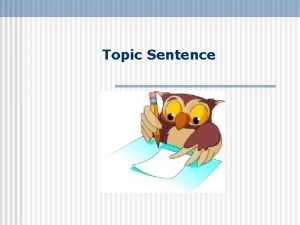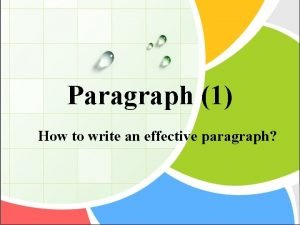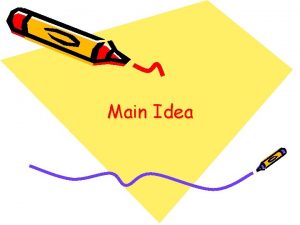Topic Sentences Identifying the Main Idea in Text












- Slides: 12

Topic Sentences Identifying the Main Idea in Text

• After determining the topic, or subject matter, of a paragraph, good readers always ask themselves What is the key point the author makes about the topic? What is the main idea that all the information in the text points toward? • In paragraph length text this key idea, this main idea sentence, this controlling sentence is called the TOPIC SENTENCE of the paragraph. • Students improve their reading comprehension skills as they learn to quickly, efficiently, and accurately identify the topic sentence, the main idea of the text.

Topic Sentence • The first point to note is that the TOPIC and TOPIC SENTENCE are not the same thing. • The TOPIC is the concept or subject of the text. It is what the paragraph is about. It can be a single word or a short phrase. It is not a complete idea • The TOPIC SENTENCE, on the other hand, is the author’s idea about the topic.

• The topic sentence might be the author’s opinion on a topic. It might be the author’s description of some place, person, or object. It might be the author’s critique of some idea. It might be the author’s instructions for a process, or the author’s observations about some process. • Unlike the topic, a topic sentence is not a phrase, but a complete thought expressed in a complete sentence.

• A topic sentence is a broad, general idea rather than narrow and specific as it covers a number of possible meanings like an umbrella “covers” a number of things. • The topic sentence in a paragraph, or even multiple paragraph texts, needs the specific sentences in the rest of the paragraph to narrow and focus the main idea, giving that topic sentence specific meaning. • Let’s look at an example, a paragraph from our recent quiz.

Identifying the Main Idea • Smoking has been proven dangerous to people’s health, yet many continue to smoke for various reasons. For many young people, smoking often represents maturity and individuality. Many smoke as a way to reduce tension. In addition, the regular smoker becomes addicted psychologically and physically to the nicotine in cigarettes. • We have already determined that the topic of this text is “reasons for smoking. ” The first sentence is the topic sentence- the author’s main point (marked in orange). To paraphrase the author’s idea, his point is that even though smoking is dangerous, “many continue to smoke for various reasons. ”

• The topic sentence is broad, general, and a bit vague. A reader might ask If smoking is dangerous, what reasons could a person have for continuing to smoke? What does this author mean by “various reasons”? • The more narrow, specific sentences in the rest of the paragraph (marked in green) explain several reasons people continue to smoke in spite of the dangers. The specific ideas, the specific sentences, the specific reasons give meaning to the main idea, the topic sentence.

Main Idea at Beginning • In the example text you just read, the author’s main idea was the first sentence in the paragraph. The following sentences developed the author’s idea by giving specific support, information, and details. • This is a very common pattern used by the authors of college textbooks. The general idea is stated at the beginning of the paragraph, and the supporting details- whatever the specific information the author selects- follow and focus and develop the main idea. • We can express this structure of the text visually. Main Idea > Support Detail >Support Detail. Or better: MI>SD>SD

• Textbook authors often use variations on this basic pattern of the main idea at the beginning of the text. For example, an author might pose a question as the first sentence of the paragraph to get the reader thinking, and follow the question with the main idea and specific ideas. That pattern would be Q>MI>SD>SD. • Other times the author might simple give a sentence or two as introduction and follow with the main idea sentence and specific ideas. That pattern would be Intro>MI>SD>SD.

• Whether the paragraph opens with the main idea as the first sentence or if the main idea follows an opening question or if the main idea follows brief introductory sentences, the student reader looks for the author’ key idea, the main point of the text, toward the beginning of the paragraph. • Several paragraphs may occasionally be grouped as specific support text that follows a general, main idea in an opening paragraph. Readers must be alert to spot and comprehend the author’s presentation of key ideas and specific support ideas.

Main Idea as Ending • A second common location for the main idea in college textbook paragraphs is the exact opposite of the first pattern. Often author’s open the paragraph with specific information, specific ideas of many types, which is followed at the end of the paragraph with a summary sentence that is broad and general and “covers” the specific details. • This ending summarizing sentence serves as the author’s main idea. We can visually describe this pattern as well. SD>SD>SD>MI. • Let’s look at an example paragraph that features this second pattern.

• When autumn arrives, the days grow shorter and the nights grow longer. The temperatures become chilly and the north winds blow. The Canada geese and snow geese appear on the lake, stay for a day or two, and continue south. Songbirds, like the robins, disappear from the backyards as they join the journey south. Even butterflies flutter their way south in a colorful parade. Many species- including some humans- migrate to warmth and lighter days in the winter. • Notice that the author has introduced a topic and presented specific ideas in green. • The last sentence summarizes the specific ideas into a broad general idea in red that is the main idea of this text. This pattern is the opposite of the first pattern and is very commonly used in college textbooks.
 Types of main idea
Types of main idea Main idea and supporting details example
Main idea and supporting details example Topic sentence about train system
Topic sentence about train system Body paragraph example
Body paragraph example How many sentences are in a paragraph
How many sentences are in a paragraph Topics presented in chapters
Topics presented in chapters Theme vs main idea
Theme vs main idea Topic and concluding sentences examples
Topic and concluding sentences examples Effective paragraph
Effective paragraph Central idea is
Central idea is Main idea and controlling idea
Main idea and controlling idea What's the big idea
What's the big idea What is irrelevant sentence example
What is irrelevant sentence example



